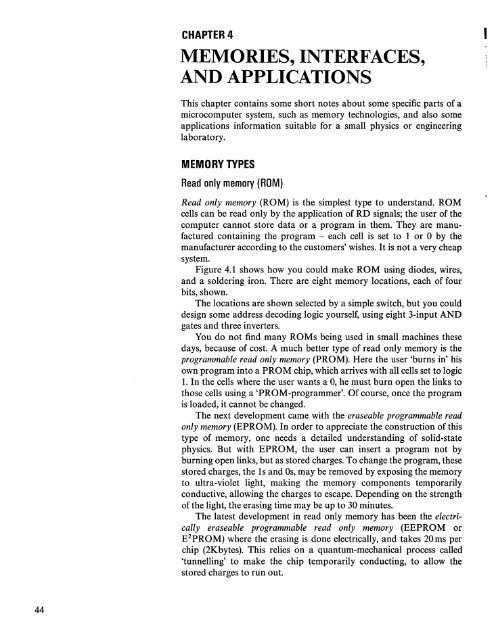Microcomputer Circuits and Processes
Microcomputer Circuits and Processes
Microcomputer Circuits and Processes
Create successful ePaper yourself
Turn your PDF publications into a flip-book with our unique Google optimized e-Paper software.
CHAPTER 4<br />
MEMORIES, INTERFACES,<br />
AND APPLICATIONS<br />
This chapter contains some short notes about some specific parts of a<br />
microcomputer system, such as memory technologies, <strong>and</strong> also some<br />
applications information suitable for a small physics or engineering<br />
laboratory.<br />
MEMORY<br />
TYPES<br />
Read only memory (ROM)<br />
Read only memory (ROM) is the simplest type to underst<strong>and</strong>. ROM<br />
cells can be read only by the application of RD signals; the user of the<br />
computer cannot store data or a program in them. They are manufactured<br />
containing the program - each cell is set to 1 or 0 by the<br />
manufacturer according to the customers' wishes. It is not a very cheap<br />
system.<br />
Figure 4.1 shows how you could make ROM using diodes, wires,<br />
<strong>and</strong> a soldering iron. There are eight memory locations, each of four<br />
bits, shown.<br />
The locations are shown selected by a simple switch, but you could<br />
design some address decoding logic yourself, using eight 3-input AND<br />
gates <strong>and</strong> three inverters.<br />
You do not find many ROMs being used in small machines these<br />
days, because of cost. A much better type of read only memory is the<br />
programmable read only memory (PROM). Here the user 'burns in' his<br />
own program into a PROM chip, which arrives with all cells set to logic<br />
1. In the cells where the user wants a 0, he must burn open the links to<br />
those cells using a 'PROM-programmer'. Of course, once the program<br />
is loaded, it cannot be changed.<br />
The next development .came with the eraseable programmable read<br />
only memory (EPROM). In order to appreciate the construction of this<br />
type of memory, one needs a detailed underst<strong>and</strong>ing of solid-state<br />
physics. But with EPROM, the user can insert a program not by<br />
burning open links, but as stored charges. To change the program, these<br />
stored charges, the Is <strong>and</strong> Os,may be removed by exposing the memory<br />
to ultra-violet light, making the memory components temporarily<br />
conductive, allowing the charges to escape. Depending on the strength<br />
of the light, the erasing time may be up to 30 minutes.<br />
The latest development in read only memory has been the electrically<br />
eraseable programmable read only memory (EEPROM or<br />
E 2 pROM) where the erasing is done electrically, <strong>and</strong> takes 20ms per<br />
chip (2Kbytes). This relies on a quantum-mechanical process called<br />
'tunnelling' to make the chip temporarily conducting, to allow the<br />
stored charges to run out.<br />
44











